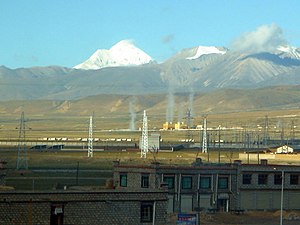 Image via Wikipedia
Image via Wikipedia
A geothermal power station is one which
runs on steam that comes out of the
ground – more specifically, steam that comes out of the ground at some temperature, pressure and volume.
The steam is run into pipes, which then run to a power station with a turbine that drives an alternator. There is no heat exchanger – the steam runs straight into the turbine, which is specially designed for relatively low temperatures and pressures.
These types of power stations are not found in South Africa, or at least not at present, but they are found in the US and other parts of the world and in Africa, particularly in Kenya, where the largest geothermal power station in Africa is located.
Geothermal steam is found mostly in the African Great Rift Valley and, for example, in Kenya, it can be at pressures of 5 bar and at temperatures of up to 500 ˚C.
There are a number of interesting problems relating to the use of geothermal steam. Firstly, it does occur on ground surfaces as freely escaping steam but, to supplement this, one has to drill for it.
The steam, which is tapped, has to travel some distance and it is conveyed in pipes. The steam is also not dry – it has a water component – and, as a consequence, it has to be separated out before the steam runs into the turbine.
The water thus separated has a very high chemical salt content and this has to be disposed of – the most convenient means is to inject it back into the hole from which the steam came to begin with. This water is known as ‘brine’.
Mixed up with the steam is also the
‘sulphur of hell’, or hydrogen sulphide. This has the endearing characteristic of smelling like rotten eggs in low concentration but, fortunately, you cannot smell it in high concentration which, in any event, is of no consequence since, in high concentrations, it will poison you within a few minutes. Thus, control of this gas in any geothermal plant is of some importance.
The brine poses other problems. At the output side of the plant, electricity travels down the power line to consumers. If the lines cross a steam supply pipe and if one conductor were to fall onto the pipe or onto the ground near a pipe, then the fault current
would flow into the pipe and, ultimately, back to the power station, into the frame of the turbine and through all the metalwork and bearings and so on and mess the whole installation up.
On gas-fired plant, you can put in a stretch of insulating pipe to stop the fault current but, since the steam pipe is filled with brine, Awhich conducts electricity, this will not help. There are a number of ways to overcome this, all of some complexity.
Does South Africa have any geothermal
resources? It is probable that we do, in the Western Cape, and in Namibia. There is a whole belt of hot water springs which
extends from Paarl to the Karoo and Aliwal North – and down below there must be steam.
They will have to be drilled for but there is no doubt that some of them are there. There is also no doubt that, under the current tariff structures that Eskom is prepared to offer,
nobody is going to try soon. We have gas off the coast, about 4 000 MW of untapped hydro, and any amount of sunshine, and Eskom is busy building two coal-fired power stations the cost of which is so high that they will never recover their construction costs in power sales (no doubt, owing to any amount of hidden costs that government hopes remain very well hidden).
So what will happen? The simple answer is no geothermal power in my lifetime. But it is comforting to know that Kenya, hardly
an industrial giant, is trying and succeeding in using renewable geothermal energy. Who
knows, some tens of years from now, we may approach the East African country, cap in hand, and ask to share the technology with us. Let’s hope they are nice about it . . . and that it happens.













